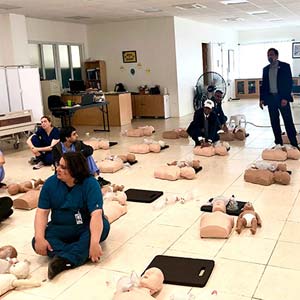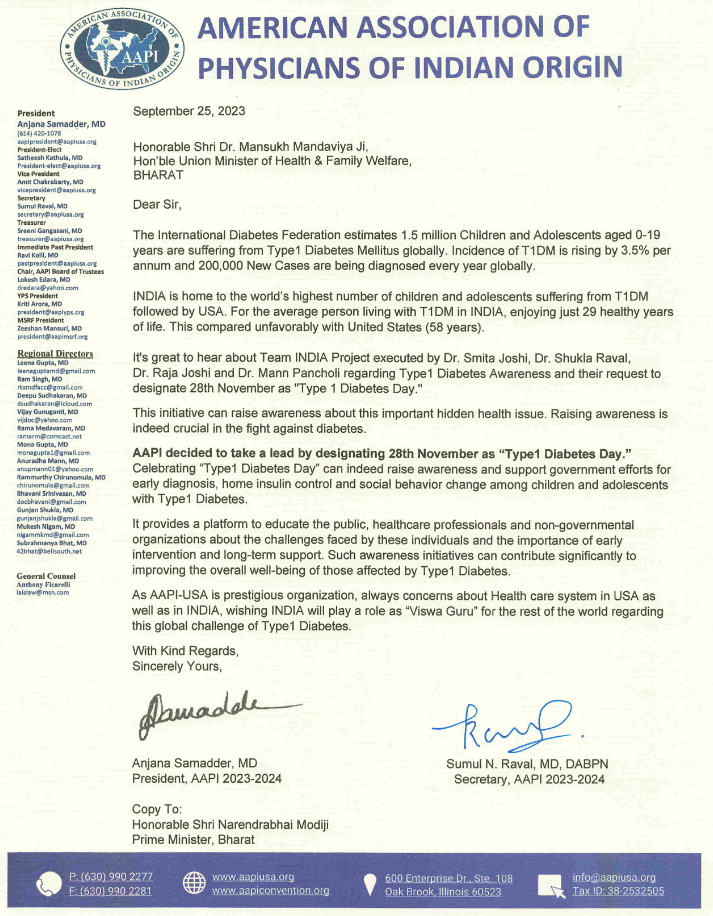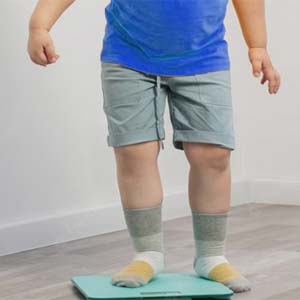Mentorship
Clinical Observership For FMGs

Clinical Observership Program
RAVI KOLLI, MD
PRESIDENT, AAPI
SHARMA PRABHAKAR, MD
Chair
Dr. Sharma Prabhakar is a Tenured Professor in the Departments of Medicine and Cell Physiology and Molecular Biophysics at Texas Tech University Health Sciences Center and a distinguished Nephrologist at Texas Tech Health Center.
He is also the Chief of Nephrology Division and Vice Chairman, Department of Medicine.
He is the principal investigator of a number of clinical studies and has over 100 publications including original articles, reviews, book chapters and published abstracts in prestigious journals. He has recently published a reference book entitled “Advances in the Pathogenesis of Diabetic Nephropathy”. Dr. Prabhakar was awarded an endowed chair by the
University Medical Center. He is the current President of American Federation for Medical Research.
ARUNABH TALWAR, MD
CO-Chair
Associate Professor, Institute of Health Innovations & Outcomes Research, Feinstein Institutes for Medical Research. Director and Investigator, Pulmonary Function Laboratory and Rehabilitation, North Shore University Hospital Professor, Medicine, Donald and Barbara Zucker School of Medicine at Hofstra/Northwell
PARAG MEHTA, MD
Member
Dr. Parag Mehta, MD FACP is the Senior Vice Chairman of the Department of Medicine at New York Methodist Hospital. He is also the Chief Medical Information Officer (CMIO) and a Clinical Assistant Professor at Weil Medical College, a Cornell University affiliate. He is Board Certified in Internal Medicine, Hospital Medicine, as well as Hospice & Palliative Care Medicine. He is also certified in Health Information Technology.
VIRENDRA JOSHI, MD
Member
Dr. Joshi Virendra completed Internal Medicine Residency, at the University of Illinois Chicago Michael Reese Hospital, Chicago, Illinois in 1995. In 1996 he was Physician-Scientist at the Institute of Molecular Medicine, Department of Internal Medicine, Section of Gastroenterology, Hepatology and Nutrition, Medical college of Georgia, Augusta, Georgia. Dr. Virendra completed his Gastroenterology, Hepatology and Nutrition Fellowship, Department at the Medical College of Georgia, Georgia Health Sciences University, Augusta Georgia in 1998
VANDANA AGARWAL, MD
CO-Chair
Accomplished Board Certified Internist, Medical Oncologist and Hematologist in Private practice since 1989 with deep commitment to providing highest level of care to patients in office setting. She did her Fellowship at prestigious Kenneth Norris Jr. Cancer Research Institute and has enjoyed teaching medical students, Interns, Residents since 1989.She also serves as a Mentor to Medical students at UC Riverside, and serves as a faculty at Western University of Medical Science.
HIMANSHU PANDYA, MD
CO-Chair
Dr. Himanshu Pandya, MD specializes in internal medicine in Floral Park, NY and has over 23 years of experience in the field of medicine. He graduated from his medical school with his medical degree in 1997. He is affiliated with numerous hospitals in New York and more, including Mount Sinai Hospital. Dr. Himanshu Pandya is licensed to practice by the state board in New York
NAGESWARA MANDAVA, MD
Member
Chairman & Program Director Flushing Hospital Medical Center
MURALI ANKEM, MD
Member
SUDHIR SRIRAM, MD
Member
Sudhir Sriram, MD, specializes in neonatology, working with a multidisciplinary team of experts to provide care for critically ill infants. He also is actively involved in the field of perinatal epidemiology, studying the impact of environmental and genetic factors on the incidence of disease during pregnancy and infancy.A dedicated educator, Dr. Sriram teaches medical students, residents and fellows about various aspects of neonatology — both in the classroom and at the bedside. In addition to giving lectures on topics such as respiratory, renal and gastrointestinal physiology, Dr. Sriram emphasizes the importance of establishing strong doctor-patient relationships.
AMERICAN ASSOCIATION OF PHYSICIANS OF INDIAN ORIGIN (AAPI)
OBSERVERSHIP PROGRAM
American Association of Physicians of Indian origin (AAPI) Clinical Observership Program aims to acculturate International Medical Graduates to American medical practices and help prepare them for Residency. The program follows the American Medical Association International Medical Graduates (AMA-IMG) section observership guidelines.
Definitions:
Mentor: AAPI members who are willing to act as mentors
Preceptor: Observer: Foreign Medical Graduates of Indian decent or Indian heritage
Application Instructions:
Interested candidates can apply by filling out the AAPI Observership Application and providing the necessary documentation. Applications will be reviewed by the AAPI Observership Committee and applicants will be accepted for 4-weeks rotation upon approval. By the end of the observership, both preceptors and observers are required to submit an evaluation form to the observership committee.
- An observer who is looking for a clinical observership will contact AAPI for this opportunity.
- AAPI will arrange clinical observership for the observer through its members who are willing to act as mentors.
- The observer will sign a contract with AAPI.
- The observer will pay a fee of $1,500 for the observership program to AAPI of which $1,000 will be paid to the institution.
- Depending on the performance of the observer, he/she might obtain a Letter of Recommendation from the preceptor.
- All observers will be awarded a Certificate upon successful completion of the observership program.
- Observe how the preceptor physician interacts with patients, takes history, performs the physical examination, orders labs and imaging, reaches a diagnosis, and finalizing the management plan.
- Learn new bedside history taking and physical examination skills by shadowing U.S. trained graduates and board certified staff with different specialties.
- Study professional communication and interaction between the physician and all members of the health care delivery team and hospital administration.
- Understand and use American colloquialisms (slang, euphemisms, medical jargon, etc.).
- Observe the delivery of health care in a private practice, hospital or clinical setting.
Introduction to and cultivation of the six competencies recommended by the Accreditation Council for Graduate Medical Education (ACGME). Residents in residency training are evaluated based on these competences.
1. Patient Care
2. Medical Knowledge
3. Practice Based Learning and Improvement
4. Systems Based Practice
5. Professionalism
6. Interpersonal Skills and Communication
Requirements:
- Must be a graduate of an international medical school.
- Must Hold a valid U.S. visa, green card, temporary protection status (TPS) or be an American citizen.
- Passing at least one of the United States Medical Licensing Examinations (USMLE) Step 1, Step 2 CK or Step 2 CS. However, few programs might require ECFMG certificate at the time of application. (I.e. completed step 1, 2CK, and Step 2CS).
- Send at least 1 reference letter by a physician practicing in the U.S. This can be a resident physician.
- Be proficient in English.
Fees:
There are no fees for AAPI Observership applications; however, some institutions require fees for the observership. The applicant will be responsible for these fees and has to pay
them after acceptance into an observership position.
Required documents:
- Completed AAPI observership application form
- Copy of a valid U.S. visa
- Copy of medical school diploma and medical school transcript
- USMLE scores and ECFMG certificate if available.
AAPI’s Role:
- Establish the Observership Program guidelines and selection criteria.
- Promote the program to interested observers and preceptors.
- Review observer and preceptor applications.
- Match observers and preceptors based on established criteria and prerequisite items. (Complete application, hospital/department chair approval, current visa, passing a certain USMLE test, etc.).
- Review preceptors and observers evaluation forms.
- Issue a certificate of successful completion to the observer.
- Support the application with institutional fees (if applicable).
Responsibilities of Physician Preceptors:
- Effectively communicate with observers about their roles and responsibilities while in the program.
- Assure that the observer adheres to the requirements of the program.
- Introduce the observer to the patient and obtain the patient’s verbal consent to allow observation of clinical interaction.
- Document in the patient’s medical record that an observer is present during the patient encounter after retrieving permission from the patient.
- Obtain prior approval from appropriate authority for the observation of surgery or other procedures (if applicable).
- Provide feedback and complete a formal evaluation of the observer.
Physician Preceptors must be:
- Licensed, preferably board-certified physicians who volunteer for a specified period of time.
- Licensed physicians with current hospital privileges and permission from his/her hospital, office manager, or GME office to host an observer.
Responsibilities of Observers:
- Must show interest in the program and professionalism in their conduct and assigned tasks.
- Accept no compensation.
- Follow the rules and the regulations of the hospital, clinic, or private practice and follow the instructions of the preceptor physician at all times.
- Adhere to Health Insurance Portability and Accountability Act (HIPPA) regulations.
- Participate in any prerequisite training (e.g., HIPAA) at the hospital, clinic, or private practice.
- Pay for actual costs of administrative or prerequisite items (ECFMG certification, passport, immunizations, etc.).
- Participate in the educational activities such as clinical tutorials, ward rounds, morning reports, and multi-disciplinary conferences.
- Observe the use of electronic medical information systems, health records, laboratory, and radiology reports, etc.
- Review clinical articles, posters, and publications per the discretion of preceptor.
- Arrange for transportation, meals, and lodging.
- Record observership hours and confirm your schedule and responsibilities with preceptor regularly.
To apply to the observership program, please fill the completed application form along with the required documents in PDF form to observership@aapiusa.org. Please put “Observership application enclosed for: First Name, Last Name” in the subject line. If you
have any questions, please do not hesitate to contact us at observership@aapiusa.org
* Application submission does not guarantee acceptance.
Observership:
Why?
- Letters of recommendation in the specialty
- Perceived commitment to specialty
- Personal prior knowledge of the applicant
- Evidence of professionalism and ethics
- Leadership qualities.
Benefits:
- Observe everything in the program·
- Know attending physicians and residents well
- Obtain excellent letters of recommendation or interview.
Risk:
Being observed.
Do’s:
- Follow rules (volunteer department)
- Introduce yourself
- Ask for permission
- Be professional
- Wear proper attire.
- Talk to every attending, befriend with every resident.
- Ask/Answer questions at the right time.
- Be appreciate
Don’t:
- Brag or show off
- Criticize
- Complain
- Being late or absent
Observership when?
After step 2 CK
Preparation:
Are you ready?
Conversations
Clinical management and procedures: Watch video
Academic activities: Listen to medicine lectures
CV
Personal statement
How to apply:
- Open application: Volunteer, house staff office.
- Personal connection
- Commercial observation
- Commercial observership
- AAPI
What can you do during?
- Sign out overnight
- Present a case:
- Write a case report/publish it.
- Write a debriefing about the observation.
Requirements:
- Flu shot (During flus season)
- PPD
- MMR antibody titer.
- Proof of Indian decent or Indian Heritage
References:
https://www.aafp.org/membership/involve/constituency/img.html
AMERICAN ASSOCIATION OF PHYSICIANS OF INDIAN ORIGIN (AAPI)
CLINICAL OBSERVERSHIP
1. INTRODUCTION
The process of getting a residency spot in USA is becoming competitive for IMGs and as such, “United States Clinical Experience” is very important to distinguish your application between other applicants. Searching to participate in right observership program is important. Thirty-seven percent of individuals entering the Residency Match in 2018 were International Medical Graduates (IMGs). Data from the Educational Commission of Foreign Medical Graduates show that more than 90% of IMGs report some type of U.S.-based clinical experience before successfully matching—the most common experience was a clinical observership conducted either at a hospital (40%) or a private physician practice (25%). Observerships should be regulated as a component of graduate medical education (GME). Currently, clinical observerships remain completely unregulated. Although the American Medical Association IMG Section has published guidelines on observerships and offers a voluntary listing of programs on their Web site, there is no direct oversight. An Internet-based search showed that academic centers, community hospitals, private practices, and medical associations all offer observerships. There are also several for-profit broker services. The range of advertised experiences and costs are highly variable.
Some programs cost $1,000 to observers while others charge $5,000 per month. The length of these experiences varies from a few days to several months. AAPI venturing into this new area to help medical students and graduates regardless of IMG’S or local medical students shall be a great step forward. These future physicians will patronize AAPI in the future services and strong relationship and bonding is formed at the initial level of observership.
2. DEFINITION
Clinical Observership Experience: Structured and supervised Clinical rotations administered by U.S licensed physicians and institutions. During the Clinical Experience, physician sponsors may employ licensed Nurse Practitioners, Physician Assistants, or other licensed professionals who participate in licensed care of their patients. Visitors may be assigned to these professionals for a partial duration of their rotation, while still remaining under the direct supervision of a U.S physician.
3. OBSERVERSHIP ONLY
An observership shall be strictly an observational tutorial program. Accordingly, each Participant shall only be permitted to observe the activities and to discuss his/her observations with applicable designated mentor. A Participant shall not have access to hands-on patient care or contact, examination, research or other work during his/her observership. A Participant shall at all times be treated by the entity as a visitor and any Department or physician that allows a Participant to do more than observe may be denied the privilege of having observership Participants in the future.
AAPI’s Role
- AAPI will arrange clinical observership for Foreign Medical Graduates through its members who are willing to act as mentors.
- Observers [AAPI MEMBERS] will be compensated for their work. [$1,000 per month]
- A Foreign Medical Graduate who is looking for a clinical observership will contact AAPI for this opportunity.
- The Student will sign a contract with AAPI. The Organization will be compensated to the tune of $1,500 per month in order to arrange for this observership
AAPI OBSERVERSHIP
A. SERVICES PROVIDED
I. Institution/Mentor shall host visitors in their 4-week Hands On Clinical Experience Program, effective from the date of this signing on the condition that AAPI is able to locate and place a Visitor. Further, Institution agrees to provide direct physician supervision of Visitor during the entirety of the Clinical Experience. The clinical experience shall include at least 4 days a week of instruction for the 4-week period.
II. Invitation: If requested, Institution/Mentor shall provide a signed invitation letter to the visitor for the purpose of travel and visa issues. AAPI shall follow all institutional regulations and guidelines regarding hosting a clinical visitor. Physician/Institution shall provide to AAPI a full list of necessary documentation regarding Visitor orientation in their Clinical Experience. If visitor fails to attend for any reason, the agreement shall be null and void for that 4-week period, and Institution shall not be entitled to any compensation for that period.
III. Institutional Mentor: Once Institution/Mentor and AAPI have confirmed a student for a 4-week period and student has paid, the agreement is considered valid for that 4-week period. Once Institution/Mentor has confirmed for the time period, Institution /Mentor shall notify AAPI of physician cancellation at least 60 days in advance of visitor start date. This agreement will renew annually unless either party terminates the agreement with at least 60 days’ notice by written or electronic mail.
IV. Supervision: Institution/mentor shall assign visitor a board licensed
V. Physician supervisor for the entirety of their clinical experience, this supervisor shall provide clinical supervision and oversight of Visitor’s clinical experience. Both parties shall designate a specific liaison to serve as a point of contact between the Parties for the purpose of exchanging paperwork and communications regarding Visitor’s and Institution’s Clinical Experience.
VI. Substitution Policy: Institution/mentor shall, in absolutely no circumstance, substitute visitors for Institution staff for any purpose, function or task while visitor is participating in the clinical Observership experience. Institution staff and supervisors shall, under no circumstances, allow visitor knowledge, opinion, or skill to influence any decision relating to patient care that is the responsibility of Institution staff.
VII. AAPI Responsibility AAPI shall be responsible for collecting and reviewing visitor applications and placing visitors that maintain good standing with their home institution. AAPI shall ensure that all required paperwork, orientation materials, and on-boarding procedures that are required by institution/ Mentor are completed and sent to institution prior to Visitor start date.
VIII. AAPI Housing Service AAPI may provide visitors with housing resources in the area of Institution. Visitor is solely responsible for choosing and reserving housing that best fits their needs.
4. COMPENSATION
AAPI shall compensate Institution/Mentor the sum one thousand dollars ($1,000) USD per visitor for each four-week Clinical Observership. AAPI shall provide compensation within 5 business days of clinical experience completion.
A. Refund Policy:
Institution/Mentor shall, in the event that if they are unable to provide the full four-week Clinical Experience, refund or relinquish claim to all of the compensation paid for each full week where no instruction was possible. The amount shall be twenty-five percent (25%) for each full week the Clinical Experience was unavailable.
5. CONFIDENTIALITY:
Each physician shall ensure that a Participant maintains the confidentiality of records and files of the University during a Participant’s observership.
6. EVALUATION AND CRITIQUE
In order to ascertain the effectiveness of the program, each party shall evaluate each other prior to issuing any certificate of completion. Process of Evaluation determines whether program activities have been implemented as intended and resulted in certain outputs. Results of a process evaluation will strengthen AAPI’s ability to report on the program and use information to improve future activities.
6. ADDITIONAL FOLLOW UP
AAPI General Counsel is further researching into the issues of liability and insurance coverage for such program and shall update the EC on its findings.
Global Medical Education
Clean Drinking Water Project

Requirements & Roles
Successful and sustainable operations lifecycle of Community Clean Water Programs depends on the following key requirements:
1. Village Selection Criteria and Responsabilities
- Cluster of 15 villages within a radius of about 60-80 km
- Population of village of 500 households and above
- Availability of raw water source that has been tested to be contaminated
- Willingness of village leadership to support the initiative on the terms proposed
- No proximity to existing water treatment suppliers operating in region

[Note: Telengana State has launched Mission Bhagiratha to supply piped water to every home, hence this region is not under consideration currently]
2. Village Responsibilities – Agreement with Panchayat
- Provide continuous and sufficient raw water source for capacity of the water treatment plant –lower water levels will impact the functioning
- Provide site with a secure room to house water treatment equipment – concrete structure of 12’ x 15’ with foundations for treated water tank and raw water tank
- Provide electricity connection for the water treatment plant
- Residents pay nominal water consumption charges of in the range of Rs 5 to Rs 8 per 20 liters
- Promote consumption of treated clean water
- Commit to a goal of achieving consumption level that will cover the annual operating and maintenance costs
3. CPW Responsibility
- Facilitate village selection criteria are met as per #1
- Establish the need for water treatment based on laboratory test and analysis of raw water source
- Establish Agreement with Panchayat with support of AAPI members
- Install water treatment plants
- Operate and maintain plants post-installation
- Collect water consumption charges per agreement
- Revenue from water consumption charges utilized towards expenses for:
- One local operator
- Electricity
- Maintenance
- Provide CPW services at zero profit, zero loss
- Until the village attains break-even point, where expenses for operations and annual maintenance are fully met from water consumption revenues, the gap is to be borne by sponsor.
4. AAPI Members Responsibility
- Sponsor the Capital cost of water treatment plants for a tax deductible contribution of USD 5,000 per village
- Sponsor the Operating & Annual Maintenance cost estimated at USD 1000 per year tax deductible. This amount varies based on region-wise cost differences, volume of water consumption and the collections thus generated. Typically, it takes about two years of operations to break-even on this cost.
- Facilitate interactions with village leadership and support to execute requisite agreement with CPW
- Support outreach, education and advocacy to encourage consumption of treated water.
[Note: Villages will be selected based on #1 and #2 above]
Childhood Obesity Awareness Campaign
Cancer Care

AAPI partnering with TATA Trusts to fight against
Cancer in India
AAPI is partnering with Tata Trust to improve health care for people in rural India. Nearly 75% of the poor population of the country resides in villages.. They lack access to even basic medical care. India is facing an enormous burden of 1.9 million new cases per year. Most of these present at an advanced stage thus necessitating complex and expensive treatments. A majority of these patients are visiting a doctor for the first time in their life. There is a significant gap between the needs and the availability of physician and health care resources for rural cancer patients. The need to travel to metropolitan areas, the cost and the delay in receiving care for these villagers further compromises the care they can obtain leading poor outcomes.
Tata trust is developing a distributive model for cancer care with digitally connected centers across the country to address this discrepancy in the delivery of cancer care to the poor in the villages. The network will integrate primary health centers, district hospitals to medical colleges. As India lacks adequate number of qualified Oncology specialists they would like to partner with AAPI to provide Medical ,Surgical and Radiation oncologists to deliver quality cancer care. These specialists will spend from one to three months in Tata cancer centers in India. They will also provide Tele-medicine consultations. The model envisions an integrated well connected network of existing and additional centers staffed by local and AAPI volunteer specialists from USA working partly in India and partly via tele-medicine from US to deliver high quality cancer care across the country i n the villages. This collaboration can also help with prevention, early detection as well as other health related areas like sanitation and safe drinking water. The trust has already embarked on forming a national cancer grid comprising major cancer centers in the country, research institutes, patient groups and charitable institutions. They will develop uniform standards of treatment, early diagnosis and prevention protocols. The specialized centers will also provide training and education besides conducting basic, transnational and clinical research.
Tata trusts will pioneer these programs with from their flagship cancer centers of Mumbai, Kolkata and the most recent center in Tirupati in A.P. This collaborative effort can not only provide much needed high quality care in an affordable manner to the impoverished in rural India but also open new vistas for joint research for local and US cancer specialists.
South Asian Heart Disease Epidemic

Turning The Clock Back On South Asian Heart Disease Epidemic
Everyone knows someone who has had a heart attack or worse died from it so this is a personal issue for many of us yet we wake up only when it is too late. It is about time we embark on a multi-year nationwide campaign of education and awareness involving physicians, patients, and the south Asian community in general. We all know Prevention is the best intervention so there is a need for a short checklist of actionable items as a road map for all of us and the next generation to stem the tide of this emerging epidemic amongst us.
South Asians constitute about 25% of the world population but account for 60% of the global cardiovascular burden. It has been generally recognized that South Asians living here or abroad are the highest-risk ethnic group for cardiometabolic disorders. AHA (American heart association) finally recognized that fact and issued guidelines last November 2019 urging physicians to consider ethnicity when determining cardiovascular risk as conventional risk prediction models underestimate our risk.
While there is consensus about higher cardiovascular risk, there is no consensus about any “smoking gun”. Most experts think the south Asian cardiometabolic epidemic is visceral obesity-mediated insulin resistance but genetic/epigenetic and inflammation also play a role . When it strikes, it does a decade earlier and many times, the first manifestation could be sudden death. The nature of this atherosclerosis is also unique in that it is diffuse and progresses rapidly in relatively smaller coronary caliber vessels making them less amenable to percutaneous or surgical intervention resulting in less-than-optimal outcomes
We are serious about bending this trajectory so we all need to fight this menace at multiple levels at the same time. First, we need a massive campaign of awareness about this nemesis using every media available by organizing community outreach programs. Second, there is a dire need for education about our phenotype which makes us more susceptible to cardiometabolic disease at lower BMI and Hgb1c levels. Third, we need to educate about the value imaging like coronary calcium score /coronary CTA provides when appropriately done to detect this silent subclinical atherosclerosis so we can act early. Fourth AAPI diet manual needs updated in view of more recent plant-based studies and incorporate interventions like yoga, and meditation to make it a more comprehensive and preventive manual. Fifth there is a need for participation in our own ongoing cohort studies to add to our database whether clinical, biological, or genetic to advance our understanding of this epidemic in the long term Finally we need to join ongoing efforts for CPR so every south Asian household especially female spouse has the skill of “Hands-only CPR” to rescue their loved ones in crucial first few minutes which can make a difference between life and death before help arrives.
I realize the task is daunting and it will take the entire AAPI village including all stakeholders local and regional and national leaders as well as other interested parties associations, Non-profit entities, and the South Asian community to make it happen. So Let us begin and learn as go. To paraphrase JFK “If not us, who? If not now, when?”
Appreciate our President Dr. Ravi Kolli for his unwavering support and trust and looking forward to your support. Please write Brahmasharma102@gmail.com for any interest or suggestions.
Brahma Sharma MD FACC
Chair, AdHoc Committee
South Asian CVD/DM
CPR Hands On Training Program

Message on CPR – Hon. Vice President of India
AAPI Video on Hands-only CPR
Speech of Hon’ble Vice President Sri M Venkaiah Naidu at Cardio Pulmonary Resuscitation CPR Event Being Organized at Swarna Bharat Trust
Dear sisters and brothers,
Heart disease has become a silent epidemic and major killer in our country. It is estimated that India accounts for 60 per cent of the world’s heart disease burden. Studies have also shown that South Asians are at higher risk for cardiac disease and that heart attacks strike at a younger age compared to other ethnic groups.
Causes such as modern lifestyle, lack of physical activity, genetic predisposition, metabolic syndrome and unhealthy dietary habits are believed to be making Indians to be more prone to heart disease.
With improved economic conditions in our country, we are facing a very high prevalence of life-style disorders such as diabetes mellitus, hypertension and coronary artery heart disease which may result in sudden cardiac arrest. Please note that a heart attack and cardiac arrest are not same. Heart attack occurs when the flow of blood to the heart gets blocked, while cardiac arrest occurs when there is a malfunction and the heart beat stops suddenly.
In the case of a sudden cardiac arrest, the event can be reversed if the victim is administered cardiopulmonary resuscitation (CPR) immediately. If these people receive CPR, the survival can double or even triple their chances of survival. Every minute counts in resuscitation of such victims.
I am told that the mortality due to Sudden Cardiac Arrest is very high in India as compared to the developed countries– 4280 per 1,00,000 population in India as compared to 60-151 per 1,00,000 in the USA.
It is estimated that 70 per cent of victims who suffer cardiac arrest at home die and it is estimated that 90 per cent of victims of cardiac arrest outside the hospital die.
To prevent the problem of high mortality after sudden cardiac arrest in our country, we need to train Indian population in CPR. Every Indian citizen can save life.
I am happy to note that the Indian resuscitation council, (IRC), an initiative of Indian Society of Anesthesiologists, has developed simple guidelines for primary delivery of CPR called Compression-only-Life Support (COLS) outside a hospital setting. I am told that the guidelines have been developed keeping in mind the limited infrastructure, cultural constraints, and availability of trained personnel and shortage of healthcare workers in our country.
I compliment the Indian resuscitation council for its efforts in developing India specific guidelines as we have been depending on AHA (American Heart association) guidelines for the last 40 years.
I am told that training according to AHA guidelines is very expensive and not within the reach of common man. I am happy that the Indian Resuscitation Council is imparting training across the country free of cost and I compliment them for the same.
I am also happy to note that members of the Indian Society of Anesthesiologists, which has a membership of 27000, are actively participating in CPR training activities across the country. I am told that 1,75,000 people were trained in COLS on 23rd October 2018 (World Restart A Heart Day – WRAH), by various organizations, under the guidance of the Indian resuscitation council.
People from Kanyakumari to Kashmir; Gujarat to Assam; small villages to metro cities; high schools to colleges, universities and nursing colleges; and primary health centers to medical colleges were trained, Training was conducted at different places including bus stands, railway stations, schools, community centers and police stations. I am glad that Rotary Club, Lions club and many NGOs took part in this initiative.
The large attendance at this programme on a single day reflects the awareness created by IRC about the importance of resuscitation training and its relevance to the common man.
I am told that India is the 7th Nation to have its’ own guidelines. International Liaison Committee on Resuscitation (ILCOR), which is like United Nation for Resuscitation Councils of different nations, has recognized this initiative of the IRC and has invited India to join this forum of principal resuscitation organizations worldwide. India is applying for the membership of ILCOR.
I would also like to compliment a large number of organizations which came forward to support this noble initiative, the Telugu Association of North America (TANA), American Association of Physicians of Indian Origin (AAPI) for sponsorship and donating manikins for the training. I compliment the District Collectors and administrations for the support and encouragement provided.
I am told that there is law in many countries to train high school students. Perhaps, we too need a law to make CPR training compulsory in schools. We need to impart this training to all personnel in public sector and private companies. We need to build an India where every citizen is capable of saving others in times of life-threatening distress.
Jai Hind!









